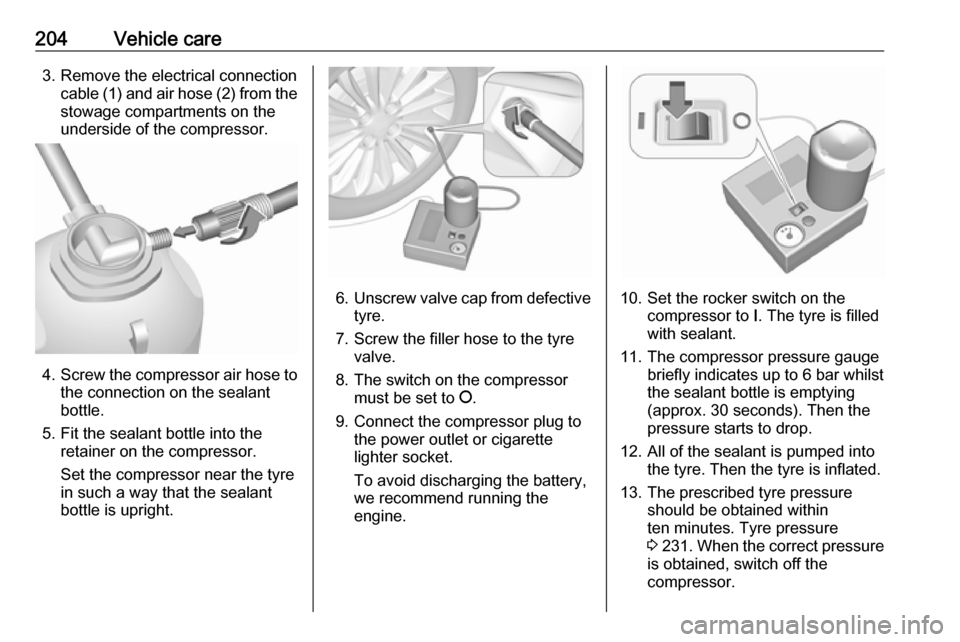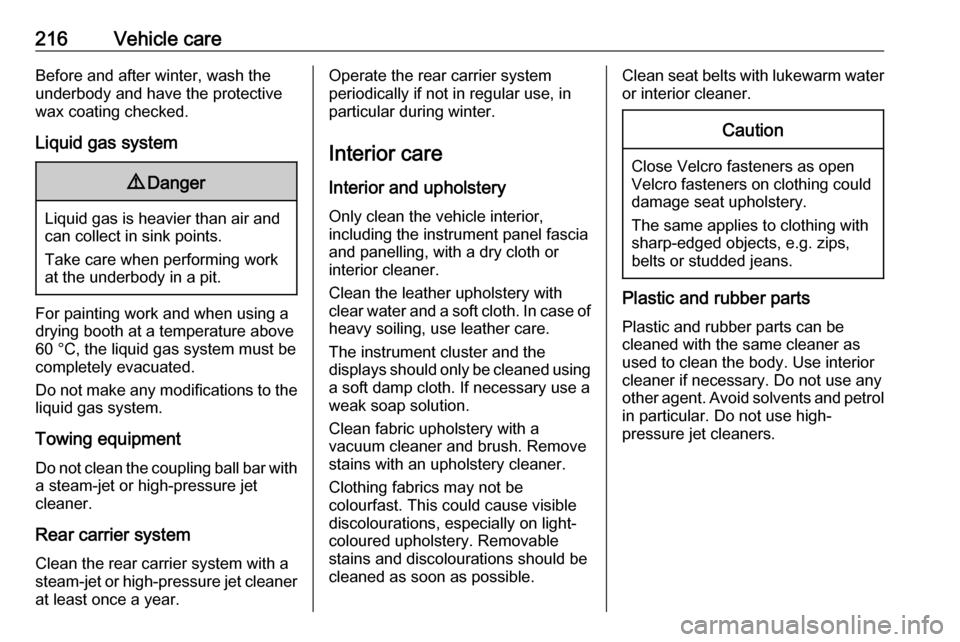light OPEL MOKKA X 2017 Manual user
[x] Cancel search | Manufacturer: OPEL, Model Year: 2017, Model line: MOKKA X, Model: OPEL MOKKA X 2017Pages: 247, PDF Size: 6.59 MB
Page 195 of 247

Vehicle care193No.Circuit1Body control module2Body control module3Body control module4Body control module5Body control module6Body control module7Body control module8Body control module9Ignition switch10Safety diagnosis module11Data link connector12Climate control13Tailgate14Central gateway module15Lane departure warning/Interior
mirror16Adaptive forward lighting17Column lockNo.Circuit18Ultrasonic park assist module19Body control module/Regulated
voltage control20Steering wheel21–22Cigarette lighter/DC accessory
power outlet (front)23Cigarette lighter/DC accessory
power outlet (rear center
console)24Spare25Telematics service module26Heated steering wheel27Instrument panel cluster/Info‐
tainment system/Auxiliary
heater switch28Trailer socket29Display/Infotainment system30Transmission control moduleNo.Circuit31Instrument panel cluster32Infotainment system33Trailer socket34Passive entry/Passive start
module
S/B Fuses
No.Circuit01Power seat switch02Spare03Power windows front04Power windows rear05Logistic mode06Power seat switch07Spare08Spare
Page 201 of 247

Vehicle care199After inflating, some driving may be
required to update the tyre pressure
values in the Driver Information
Centre. During this time w may
illuminate.
If w illuminates at lower temperatures
and extinguishes after driving, this
could be an indicator for approaching
a low tyre pressure condition. Check
tyre pressure.
Vehicle messages 3 103.
If the tyre pressure must be reduced
or increased, switch off ignition.
Only mount wheels with pressure
sensors, otherwise the tyre pressure
will not be displayed and w
illuminates continuously.
A spare wheel or temporary spare
wheel is not equipped with pressure
sensors. The tyre pressure
monitoring system is not operational
for these tyres. Control indicator w
illuminates. For the further three
tyres, the system remains
operational.The use of commercially-available
liquid tyre repair kits can impair the
function of the system. Factory-
approved repair kits can be used.
Operating electronic devices or being close to facilities using similar wave
frequencies could disrupt the tyre
pressure monitoring system.
Each time the tyres are replaced, tyre pressure monitoring system sensors
must be dismounted and serviced.
For the screwed sensor, replace
valve core and sealing ring. For the
clipped sensor, replace complete
valve stem.
Vehicle loading status Adjust tyre pressure to load condition
according to tyre information label or
tyre pressure chart 3 231, and select
the appropriate setting in the
menu Tyre Load in the Driver
Information Centre, Vehicle
Information Menu 3 97 . This setting is
the reference for the tyre pressure
warnings.The Tyre load menu only appears
when the vehicle is at a standstill and the parking brake is applied. On
vehicles with automatic transmission
the selector lever must be in P.
Midlevel display:
Select the Tyre load page under the
Vehicle Information Menu ? in the
Driver Information Centre 3 97.
● Light for comfort pressure up to
three people.
● Eco for Eco pressure up to three
people.
● Max for full loading.
Uplevel display:
Page 202 of 247

200Vehicle care
Select the Tyre load page under the
Options Menu in the Driver
Information Centre 3 97.
● Light for comfort pressure up to
three people.
● Eco for Eco pressure up to three
people.
● Max for full loading.
Tyre pressure sensor matching process
Each tyre pressure sensor has a
unique identification code. The
identification code must be matched
to a new wheel position after rotating
the wheels or exchanging the
complete wheel set and if one or more tyre pressure sensors were replaced.
The tyre pressure sensor matching
process should also be performed
after replacing a spare wheel with a
road wheel containing a tyre pressure sensor.
The malfunction light w and the
warning message should extinguish
at the next ignition cycle. The sensors
are matched to the wheel positions,
using a relearn tool, in the following
order: left side front wheel, right side
front wheel, right side rear wheel and
left side rear wheel. The turn signal
light at the current active position is
illuminated until sensor is matched.
Consult a workshop for service. There
are two minutes to match the first
wheel position, and five minutes
overall to match all four wheel
positions. If it takes longer, the
matching process stops and must be
restarted.
The tyre pressure sensor matching
process is:
1. Apply the parking brake.
2. Turn the ignition on.3. On vehicles with automatic transmission: set the selector
lever to P.
On vehicles with manual
transmission: select neutral.
4. Press MENU on the turn signal
lever to select the Vehicle
Information Menu in the Driver
Information Centre.
5. Turn the adjuster wheel to scroll to
the tyre pressure menu.
Midlevel display:
Uplevel display:
Page 206 of 247

204Vehicle care3. Remove the electrical connectioncable (1) and air hose (2) from the
stowage compartments on the
underside of the compressor.
4. Screw the compressor air hose to
the connection on the sealant
bottle.
5. Fit the sealant bottle into the retainer on the compressor.
Set the compressor near the tyre
in such a way that the sealant
bottle is upright.
6. Unscrew valve cap from defective
tyre.
7. Screw the filler hose to the tyre valve.
8. The switch on the compressor must be set to J.
9. Connect the compressor plug to the power outlet or cigarette
lighter socket.
To avoid discharging the battery, we recommend running the
engine.10. Set the rocker switch on the compressor to I. The tyre is filled
with sealant.
11. The compressor pressure gauge briefly indicates up to 6 bar whilstthe sealant bottle is emptying
(approx. 30 seconds). Then the
pressure starts to drop.
12. All of the sealant is pumped into the tyre. Then the tyre is inflated.
13. The prescribed tyre pressure should be obtained within
ten minutes. Tyre pressure
3 231 . When the correct pressure
is obtained, switch off the
compressor.
Page 213 of 247

Vehicle care211● Apply the parking brake,transmission in neutral,
automatic transmission in P.
● Open the positive terminal protection caps of both batteries.
Lead connection order:
1. Connect the red lead to the positive terminal of the booster
battery.
2. Connect the other end of the red lead to the positive terminal of the
discharged battery.
3. Connect the black lead to the negative terminal of the booster
battery.
4. Connect the other end of the black
lead to a vehicle grounding point,
such as the engine block or an
engine mounting bolt. Connect as far away from the discharged
battery as possible, however at
least 60 cm.
Route the leads so that they cannot
catch on rotating parts in the engine
compartment.
To start the engine: 1. Start the engine of the vehicle providing the jump.
2. After five minutes, start the other engine. Start attempts should be
made for no longer than
15 seconds at an interval of
1 minute.
3. Allow both engines to idle for approx. three minutes with the
leads connected.4. Switch on electrical consumers (e.g. headlights, heated rear
window) of the vehicle receiving
the jump start.
5. Reverse above sequence exactly when removing leads.
Page 214 of 247

212Vehicle careTowingTowing the vehicle
Disengage cap by using a
screwdriver and remove.
The towing eye is stowed with the vehicle tools 3 195.
Screw in the towing eye as far as it will
go until it stops in a horizontal
position.
Attach a tow rope – or better still a tow
rod – to the towing eye.
The towing eye must only be used for towing and not for recovering the
vehicle.
Switch on ignition to release steering
wheel lock and to permit operation of
brake lights, horn and windscreen
wiper.
Transmission in neutral.
Caution
Never tow a vehicle equipped with All Wheel Drive (AWD) with the
front or rear tyres on the road. If
you tow a vehicle equipped with
AWD while the front or rear tyres
are rolling on the road, the drive
system in the vehicle could be
severely damaged. When towing
vehicles equipped with AWD, all
four tyres must not be in contact
with the road.
Caution
Drive slowly. Do not drive jerkily.
Excessive tractive force can
damage the vehicle.
When the engine is not running,
considerably more force is needed to
brake and steer.
To prevent the entry of exhaust gases from the towing vehicle, switch on the
air recirculation system 3 127 and
close the windows.
Page 217 of 247

Vehicle care215Thoroughly rinse and leather-off the
vehicle. Rinse leather frequently. Use
separate leathers for painted and
glass surfaces: remnants of wax on the windows will impair vision.
Do not use hard objects to remove
spots of tar. Use tar removal spray on
painted surfaces.
Exterior lights
Headlight and other light covers are
made of plastic. Do not use any
abrasive or caustic agents, do not use
an ice scraper, and do not clean them
dry.
Polishing and waxing
Wax the vehicle regularly (at the
latest when water no longer beads).
Otherwise, the paintwork will dry out.
Polishing is necessary only if the paint
has become dull or if solid deposits
have become attached to it.
Paintwork polish with silicone forms a
protective film, making waxing
unnecessary.
Plastic body parts must not be treated with wax or polishing agents.Windows and windscreen wiper
blades
Use a soft lint-free cloth or chamoisleather together with window cleaner and insect remover.
When cleaning the rear window from
inside, always wipe in parallel to the
heating element to prevent damage.
For mechanical removal of ice, use a
sharp-edged ice scraper. Press the
scraper firmly against the glass so
that no dirt can get under it and
scratch the glass.
Clean smearing wiper blades with a
soft cloth and window cleaner.
Remove dirt residues from smearing
wiper blades by using a soft cloth and window cleaner. Also make sure to
remove any residues such as wax,
insect residues and similar from the
window.
Ice residues, pollution and continuous
wiping on dry windows will damage or
even destroy the wiper blades.Wheels and tyres
Do not use high-pressure jet
cleaners.
Clean rims with a pH-neutral wheel
cleaner.
Rims are painted and can be treated
with the same agents as the body.
Paintwork damageRectify minor paintwork damage with
a touch-up pen before rust forms.
Have more extensive damage or rust
areas repaired by a workshop.
Underbody Some areas of the vehicle underbody
have a PVC undercoating while other
critical areas have a durable
protective wax coating.
After the underbody is washed, check the underbody and have it waxed if
necessary.
Bitumen/rubber materials could
damage the PVC coating. Have
underbody work carried out by a
workshop.
Page 218 of 247

216Vehicle careBefore and after winter, wash the
underbody and have the protective
wax coating checked.
Liquid gas system9 Danger
Liquid gas is heavier than air and
can collect in sink points.
Take care when performing work
at the underbody in a pit.
For painting work and when using a
drying booth at a temperature above
60 °C, the liquid gas system must be
completely evacuated.
Do not make any modifications to the
liquid gas system.
Towing equipment
Do not clean the coupling ball bar with a steam-jet or high-pressure jet
cleaner.
Rear carrier system Clean the rear carrier system with a
steam-jet or high-pressure jet cleaner
at least once a year.
Operate the rear carrier system
periodically if not in regular use, in
particular during winter.
Interior care
Interior and upholstery Only clean the vehicle interior,
including the instrument panel fascia
and panelling, with a dry cloth or
interior cleaner.
Clean the leather upholstery with
clear water and a soft cloth. In case of
heavy soiling, use leather care.
The instrument cluster and the
displays should only be cleaned using
a soft damp cloth. If necessary use a
weak soap solution.
Clean fabric upholstery with a
vacuum cleaner and brush. Remove
stains with an upholstery cleaner.
Clothing fabrics may not be
colourfast. This could cause visible
discolourations, especially on light- coloured upholstery. Removable
stains and discolourations should be
cleaned as soon as possible.Clean seat belts with lukewarm water or interior cleaner.Caution
Close Velcro fasteners as open
Velcro fasteners on clothing could damage seat upholstery.
The same applies to clothing with
sharp-edged objects, e.g. zips, belts or studded jeans.
Plastic and rubber parts
Plastic and rubber parts can be
cleaned with the same cleaner as
used to clean the body. Use interior
cleaner if necessary. Do not use any
other agent. Avoid solvents and petrol in particular. Do not use high-
pressure jet cleaners.
Page 242 of 247

240IndexAAccessories and vehicle modifications .......................... 177
Adaptive forward lighting .....96, 119
Adjustable air vents ...................131
Airbag and belt tensioners ...........92
Airbag deactivation ................52, 93
Airbag label................................... 47 Airbag system .............................. 47
Air conditioning regular operation ................................ 132
Air conditioning system .............. 127
Air intake .................................... 131
Air vents...................................... 131
All-wheel drive ........................... 147
Antilock brake system ................ 148
Antilock brake system (ABS) .......93
Anti-theft alarm system ................30
Anti-theft locking system .............. 30
Appearance care ........................214
Automatic anti-dazzle ..................34
Automatic light control ...............116
Automatic locking ........................28
Automatic transmission .............143
Autostop ..................................... 138
Auxiliary heater ........................... 130
B Battery discharge protection ......125
Battery voltage ........................... 104Bicycle rack .................................. 61
Bonnet ....................................... 179
Brake and clutch fluid .................218
Brake and clutch system .............93
Brake assist ............................... 149
Brake fluid .................................. 182
Brakes ............................... 148, 182
Breakdown.................................. 212
Bulb replacement ....................... 186
C
Capacities .................................. 230
Catalytic converter .....................142
Central locking system ................24
Centre console storage ...............61
Changing tyre and wheel size ...202
Charging system .......................... 93
Child locks ................................... 29
Child restraint installation locations ................................... 54
Child restraints.............................. 53
Child restraint systems ................53
Climate control ............................. 16
Climate control systems .............126
Clock............................................. 81
Code ........................................... 103
Collision damage repair ..............235
Control indicators.......................... 87
Control of the vehicle .................134
Controls ........................................ 77
Page 243 of 247

241Convex shape .............................. 32
Coolant and antifreeze ...............218
Cruise control ...................... 96, 152
Cupholders .................................. 59
Curtain airbag system .................. 51
D
Danger, Warnings and Cautions ...4
Daytime running lights ...............119
Declaration of conformity ............233
Delayed locking ............................ 27
Descent control system .......94, 151
Diesel fuel system bleeding .......184
Diesel particle filter ....................142
Door open .................................... 97
Doors ............................................ 29
Driver assistance systems ..........152
Driver Information Centre .............97
Driving characteristics and towing tips .............................. 173
Driving hints ................................ 134
E
Electric adjustment ......................32
Electrical system......................... 190
Electronic climate control system 128
Electronic driving programmes ..145
Electronic key system ...................22
Electronic Stability Control.......... 150
Electronic Stability Control and Traction Control system ............94Electronic Stability Control off....... 94
End-of-life vehicle recovery .......178
Engine compartment fuse box ...190
Engine coolant ........................... 181
Engine coolant temperature gauge ....................................... 86
Engine data ............................... 225
Engine exhaust .......................... 141
Engine identification ...................221
Engine oil ................... 180, 218, 222
Engine oil pressure ......................95
Entry lighting .............................. 124
ERA GLONASS .......................... 113
Event data recorders ..................237
Exit lighting ................................ 125
Exterior care .............................. 214
Exterior light ................................. 96
Exterior lighting ....................13, 115
Exterior mirrors ............................. 32
F
Fault ........................................... 145
First aid kit ................................... 74
Fixed air vents ........................... 131
Flex-Fix system ............................ 61
Fog light ....................................... 96
Fog lights ................................... 187
Folding mirrors ............................. 32
Following distance indication ......157
Forward collision alert................. 155Front airbag system .....................50
Front fog lights ........................... 122
Front seats.................................... 40
Front storage ................................ 60
Fuel............................................. 166
Fuel consumption - CO 2-
Emissions ............................... 172
Fuel for diesel engines ..............166
Fuel for liquid gas operation .......167
Fuel for petrol engines ...............166
Fuel gauge ................................... 85
Fuel selector ................................ 86
Fuses ......................................... 190
G
Gauges ......................................... 84
Gear shifting ................................. 94
General information ...................173
Glovebox ..................................... 59
Glove box lighting .......................124
H Halogen headlights ....................186
Hand brake ................................. 148
Hazard warning flashers ............121
Headlight flash ........................... 117
Headlight range adjustment ......118
Headlights when driving abroad 118
Head restraint adjustment .............8
Head restraints ............................ 39
Heated mirrors ............................. 33